Nursing Communication: Leadership Principles in Clinical Practice
VerifiedAdded on 2023/06/11
|12
|3016
|244
Essay
AI Summary
This essay delves into the critical role of effective communication in nursing, particularly within mentorship programs. It analyzes a specific interaction between a nursing mentor and a student nurse through the lens of Eric Berne's transactional analysis model, highlighting a crossed transaction characterized by miscommunication and unmet expectations. The essay examines the verbal and nonverbal communication styles employed by the mentor, identifying both strengths and weaknesses. Furthermore, it proposes strategies for improving communication to enhance healthcare quality and foster a more supportive learning environment. The application of leadership principles is discussed, emphasizing the importance of complementary transactions, clear communication, and leading by example to ensure optimal patient care and professional development for both mentors and mentees. The mentorship program is necessary both for the mentor and the mentee. The mentor gains essential leadership skills that they can apply in an advanced role. On the other hand, the mentor learns about the standards of conduct and ethical issues in the nursing field. Mentorship provides a platform for the students to apply the theoretical knowledge learned in class into practical application. Nurses should supervise the students during mentorship programs. Mentorship boosts the confidence of the students during medical practice. A well-planned program helps.
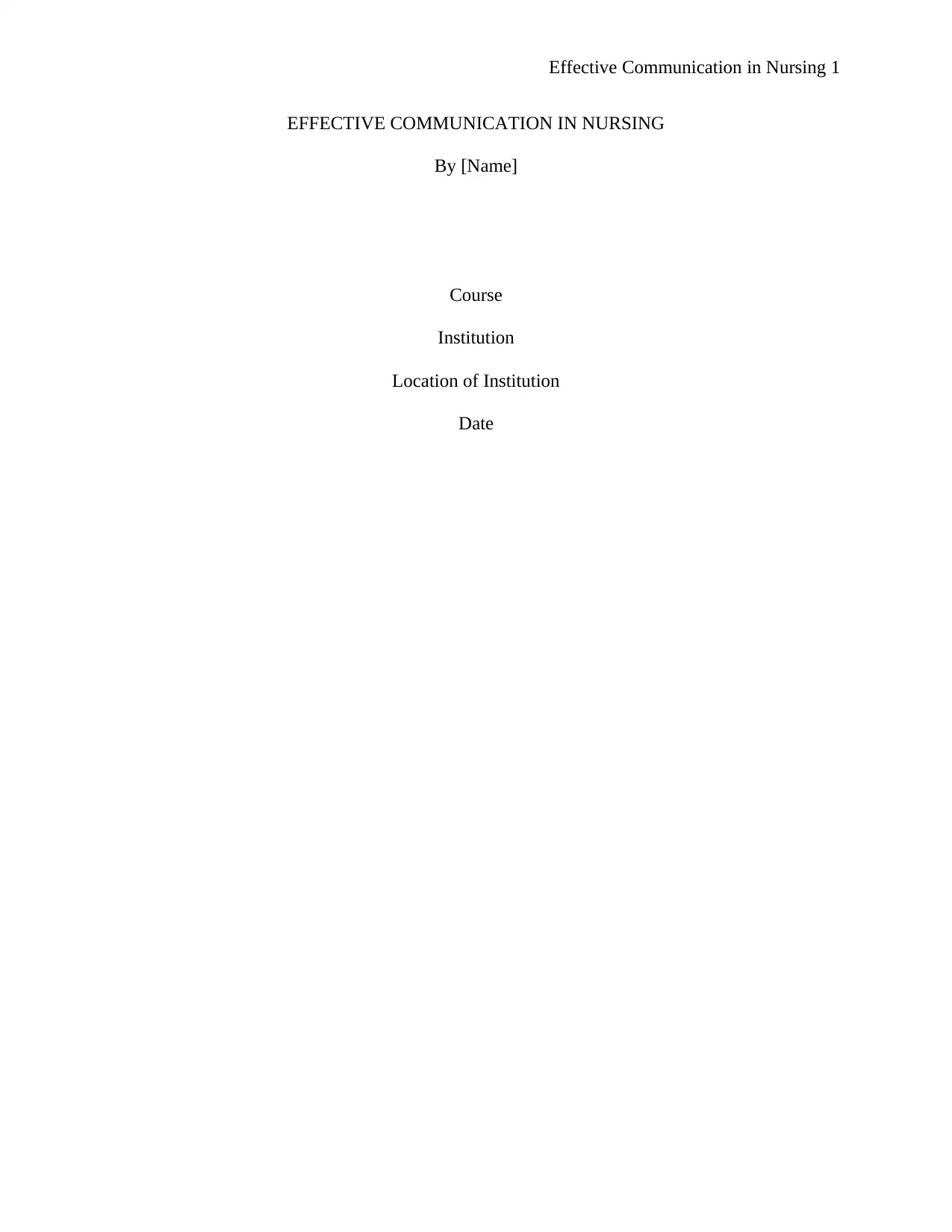
Effective Communication in Nursing 1
EFFECTIVE COMMUNICATION IN NURSING
By [Name]
Course
Institution
Location of Institution
Date
EFFECTIVE COMMUNICATION IN NURSING
By [Name]
Course
Institution
Location of Institution
Date
Paraphrase This Document
Need a fresh take? Get an instant paraphrase of this document with our AI Paraphraser
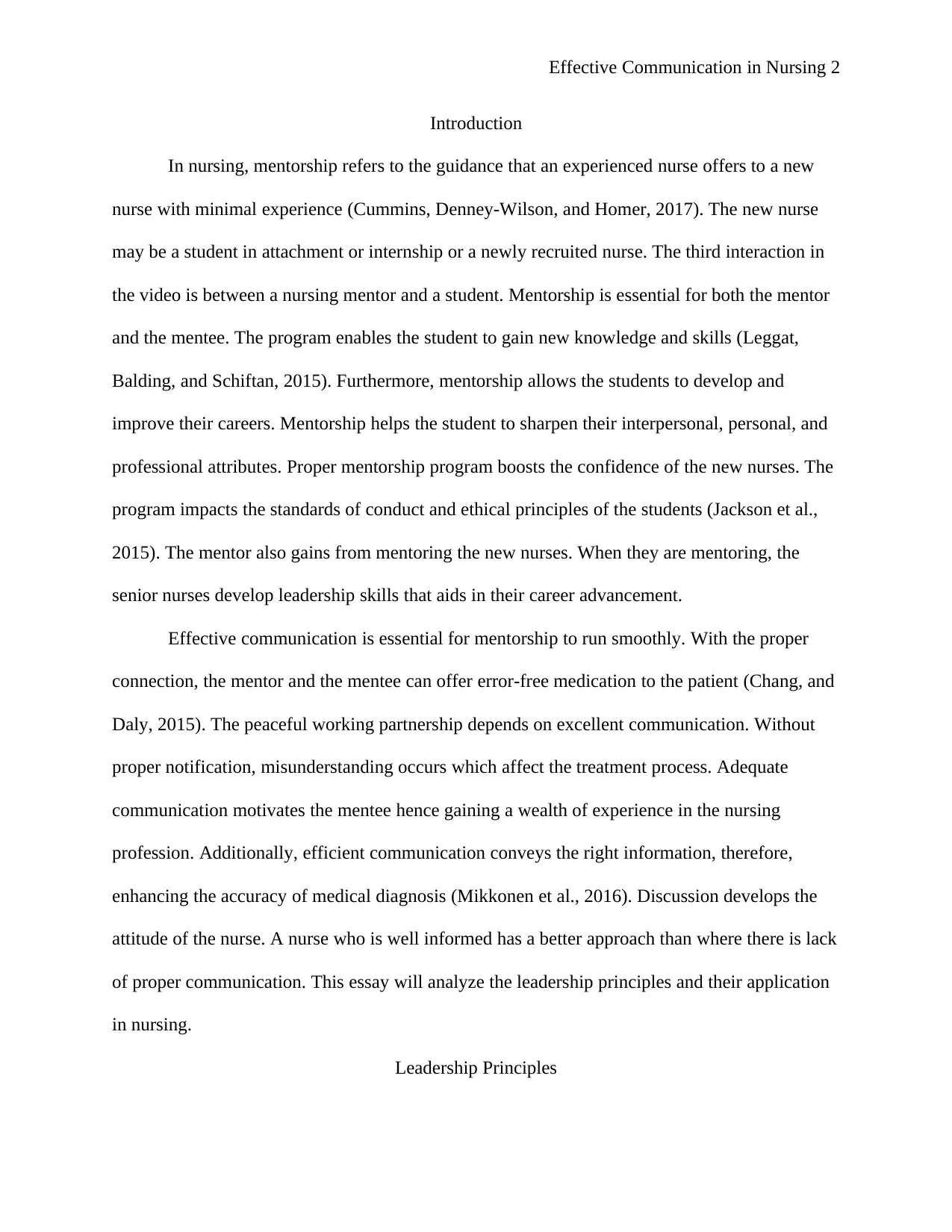
Effective Communication in Nursing 2
Introduction
In nursing, mentorship refers to the guidance that an experienced nurse offers to a new
nurse with minimal experience (Cummins, Denney-Wilson, and Homer, 2017). The new nurse
may be a student in attachment or internship or a newly recruited nurse. The third interaction in
the video is between a nursing mentor and a student. Mentorship is essential for both the mentor
and the mentee. The program enables the student to gain new knowledge and skills (Leggat,
Balding, and Schiftan, 2015). Furthermore, mentorship allows the students to develop and
improve their careers. Mentorship helps the student to sharpen their interpersonal, personal, and
professional attributes. Proper mentorship program boosts the confidence of the new nurses. The
program impacts the standards of conduct and ethical principles of the students (Jackson et al.,
2015). The mentor also gains from mentoring the new nurses. When they are mentoring, the
senior nurses develop leadership skills that aids in their career advancement.
Effective communication is essential for mentorship to run smoothly. With the proper
connection, the mentor and the mentee can offer error-free medication to the patient (Chang, and
Daly, 2015). The peaceful working partnership depends on excellent communication. Without
proper notification, misunderstanding occurs which affect the treatment process. Adequate
communication motivates the mentee hence gaining a wealth of experience in the nursing
profession. Additionally, efficient communication conveys the right information, therefore,
enhancing the accuracy of medical diagnosis (Mikkonen et al., 2016). Discussion develops the
attitude of the nurse. A nurse who is well informed has a better approach than where there is lack
of proper communication. This essay will analyze the leadership principles and their application
in nursing.
Leadership Principles
Introduction
In nursing, mentorship refers to the guidance that an experienced nurse offers to a new
nurse with minimal experience (Cummins, Denney-Wilson, and Homer, 2017). The new nurse
may be a student in attachment or internship or a newly recruited nurse. The third interaction in
the video is between a nursing mentor and a student. Mentorship is essential for both the mentor
and the mentee. The program enables the student to gain new knowledge and skills (Leggat,
Balding, and Schiftan, 2015). Furthermore, mentorship allows the students to develop and
improve their careers. Mentorship helps the student to sharpen their interpersonal, personal, and
professional attributes. Proper mentorship program boosts the confidence of the new nurses. The
program impacts the standards of conduct and ethical principles of the students (Jackson et al.,
2015). The mentor also gains from mentoring the new nurses. When they are mentoring, the
senior nurses develop leadership skills that aids in their career advancement.
Effective communication is essential for mentorship to run smoothly. With the proper
connection, the mentor and the mentee can offer error-free medication to the patient (Chang, and
Daly, 2015). The peaceful working partnership depends on excellent communication. Without
proper notification, misunderstanding occurs which affect the treatment process. Adequate
communication motivates the mentee hence gaining a wealth of experience in the nursing
profession. Additionally, efficient communication conveys the right information, therefore,
enhancing the accuracy of medical diagnosis (Mikkonen et al., 2016). Discussion develops the
attitude of the nurse. A nurse who is well informed has a better approach than where there is lack
of proper communication. This essay will analyze the leadership principles and their application
in nursing.
Leadership Principles
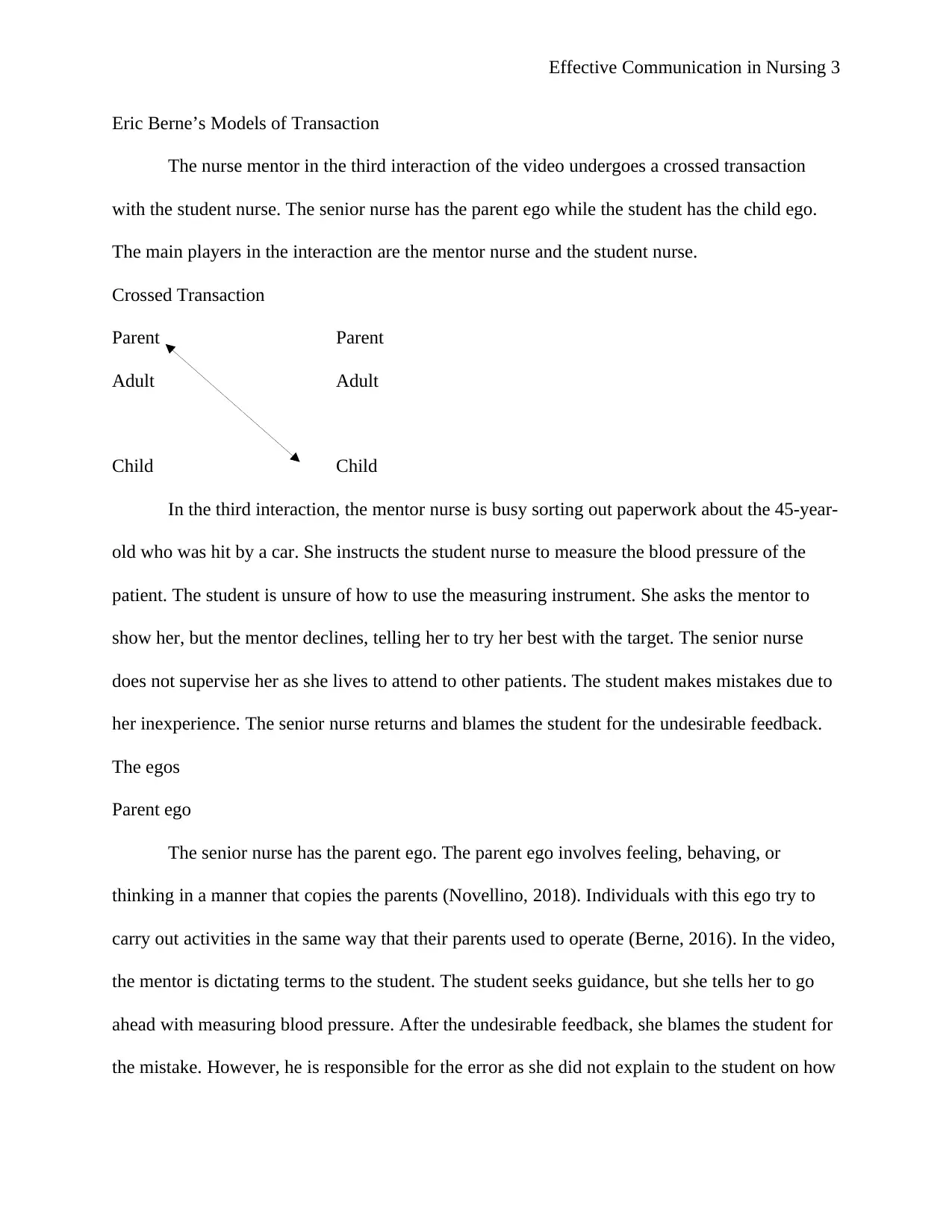
Effective Communication in Nursing 3
Eric Berne’s Models of Transaction
The nurse mentor in the third interaction of the video undergoes a crossed transaction
with the student nurse. The senior nurse has the parent ego while the student has the child ego.
The main players in the interaction are the mentor nurse and the student nurse.
Crossed Transaction
Parent Parent
Adult Adult
Child Child
In the third interaction, the mentor nurse is busy sorting out paperwork about the 45-year-
old who was hit by a car. She instructs the student nurse to measure the blood pressure of the
patient. The student is unsure of how to use the measuring instrument. She asks the mentor to
show her, but the mentor declines, telling her to try her best with the target. The senior nurse
does not supervise her as she lives to attend to other patients. The student makes mistakes due to
her inexperience. The senior nurse returns and blames the student for the undesirable feedback.
The egos
Parent ego
The senior nurse has the parent ego. The parent ego involves feeling, behaving, or
thinking in a manner that copies the parents (Novellino, 2018). Individuals with this ego try to
carry out activities in the same way that their parents used to operate (Berne, 2016). In the video,
the mentor is dictating terms to the student. The student seeks guidance, but she tells her to go
ahead with measuring blood pressure. After the undesirable feedback, she blames the student for
the mistake. However, he is responsible for the error as she did not explain to the student on how
Eric Berne’s Models of Transaction
The nurse mentor in the third interaction of the video undergoes a crossed transaction
with the student nurse. The senior nurse has the parent ego while the student has the child ego.
The main players in the interaction are the mentor nurse and the student nurse.
Crossed Transaction
Parent Parent
Adult Adult
Child Child
In the third interaction, the mentor nurse is busy sorting out paperwork about the 45-year-
old who was hit by a car. She instructs the student nurse to measure the blood pressure of the
patient. The student is unsure of how to use the measuring instrument. She asks the mentor to
show her, but the mentor declines, telling her to try her best with the target. The senior nurse
does not supervise her as she lives to attend to other patients. The student makes mistakes due to
her inexperience. The senior nurse returns and blames the student for the undesirable feedback.
The egos
Parent ego
The senior nurse has the parent ego. The parent ego involves feeling, behaving, or
thinking in a manner that copies the parents (Novellino, 2018). Individuals with this ego try to
carry out activities in the same way that their parents used to operate (Berne, 2016). In the video,
the mentor is dictating terms to the student. The student seeks guidance, but she tells her to go
ahead with measuring blood pressure. After the undesirable feedback, she blames the student for
the mistake. However, he is responsible for the error as she did not explain to the student on how
⊘ This is a preview!⊘
Do you want full access?
Subscribe today to unlock all pages.

Trusted by 1+ million students worldwide
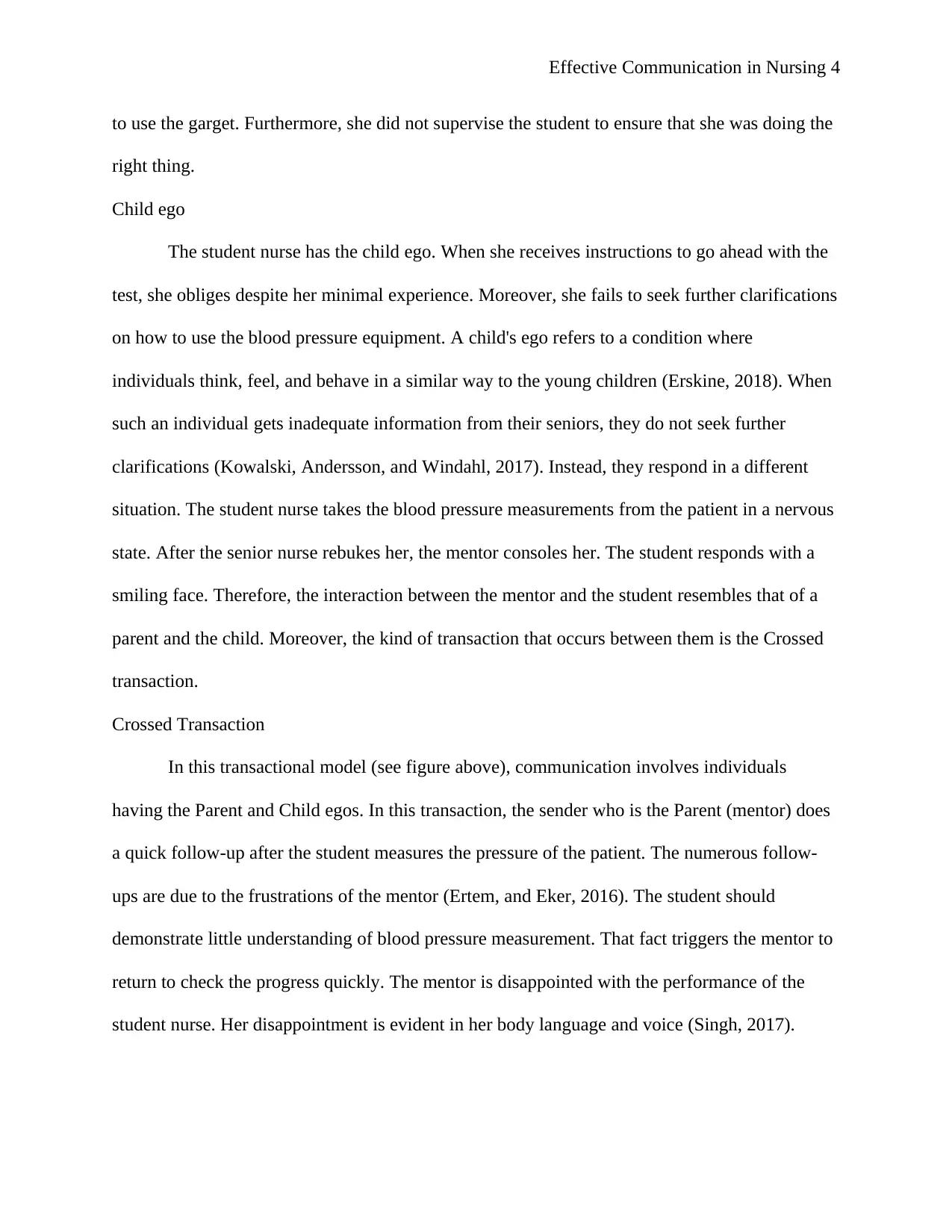
Effective Communication in Nursing 4
to use the garget. Furthermore, she did not supervise the student to ensure that she was doing the
right thing.
Child ego
The student nurse has the child ego. When she receives instructions to go ahead with the
test, she obliges despite her minimal experience. Moreover, she fails to seek further clarifications
on how to use the blood pressure equipment. A child's ego refers to a condition where
individuals think, feel, and behave in a similar way to the young children (Erskine, 2018). When
such an individual gets inadequate information from their seniors, they do not seek further
clarifications (Kowalski, Andersson, and Windahl, 2017). Instead, they respond in a different
situation. The student nurse takes the blood pressure measurements from the patient in a nervous
state. After the senior nurse rebukes her, the mentor consoles her. The student responds with a
smiling face. Therefore, the interaction between the mentor and the student resembles that of a
parent and the child. Moreover, the kind of transaction that occurs between them is the Crossed
transaction.
Crossed Transaction
In this transactional model (see figure above), communication involves individuals
having the Parent and Child egos. In this transaction, the sender who is the Parent (mentor) does
a quick follow-up after the student measures the pressure of the patient. The numerous follow-
ups are due to the frustrations of the mentor (Ertem, and Eker, 2016). The student should
demonstrate little understanding of blood pressure measurement. That fact triggers the mentor to
return to check the progress quickly. The mentor is disappointed with the performance of the
student nurse. Her disappointment is evident in her body language and voice (Singh, 2017).
to use the garget. Furthermore, she did not supervise the student to ensure that she was doing the
right thing.
Child ego
The student nurse has the child ego. When she receives instructions to go ahead with the
test, she obliges despite her minimal experience. Moreover, she fails to seek further clarifications
on how to use the blood pressure equipment. A child's ego refers to a condition where
individuals think, feel, and behave in a similar way to the young children (Erskine, 2018). When
such an individual gets inadequate information from their seniors, they do not seek further
clarifications (Kowalski, Andersson, and Windahl, 2017). Instead, they respond in a different
situation. The student nurse takes the blood pressure measurements from the patient in a nervous
state. After the senior nurse rebukes her, the mentor consoles her. The student responds with a
smiling face. Therefore, the interaction between the mentor and the student resembles that of a
parent and the child. Moreover, the kind of transaction that occurs between them is the Crossed
transaction.
Crossed Transaction
In this transactional model (see figure above), communication involves individuals
having the Parent and Child egos. In this transaction, the sender who is the Parent (mentor) does
a quick follow-up after the student measures the pressure of the patient. The numerous follow-
ups are due to the frustrations of the mentor (Ertem, and Eker, 2016). The student should
demonstrate little understanding of blood pressure measurement. That fact triggers the mentor to
return to check the progress quickly. The mentor is disappointed with the performance of the
student nurse. Her disappointment is evident in her body language and voice (Singh, 2017).
Paraphrase This Document
Need a fresh take? Get an instant paraphrase of this document with our AI Paraphraser
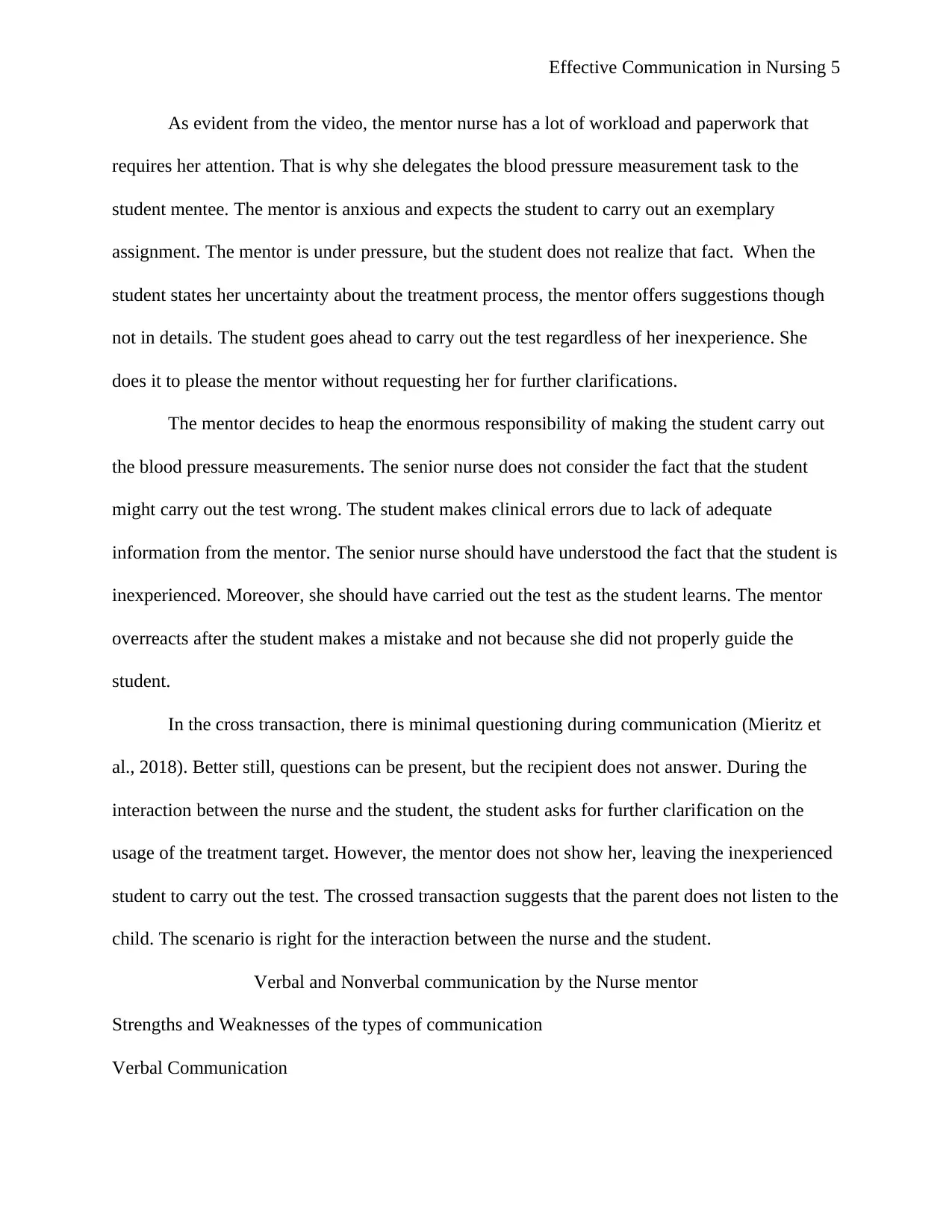
Effective Communication in Nursing 5
As evident from the video, the mentor nurse has a lot of workload and paperwork that
requires her attention. That is why she delegates the blood pressure measurement task to the
student mentee. The mentor is anxious and expects the student to carry out an exemplary
assignment. The mentor is under pressure, but the student does not realize that fact. When the
student states her uncertainty about the treatment process, the mentor offers suggestions though
not in details. The student goes ahead to carry out the test regardless of her inexperience. She
does it to please the mentor without requesting her for further clarifications.
The mentor decides to heap the enormous responsibility of making the student carry out
the blood pressure measurements. The senior nurse does not consider the fact that the student
might carry out the test wrong. The student makes clinical errors due to lack of adequate
information from the mentor. The senior nurse should have understood the fact that the student is
inexperienced. Moreover, she should have carried out the test as the student learns. The mentor
overreacts after the student makes a mistake and not because she did not properly guide the
student.
In the cross transaction, there is minimal questioning during communication (Mieritz et
al., 2018). Better still, questions can be present, but the recipient does not answer. During the
interaction between the nurse and the student, the student asks for further clarification on the
usage of the treatment target. However, the mentor does not show her, leaving the inexperienced
student to carry out the test. The crossed transaction suggests that the parent does not listen to the
child. The scenario is right for the interaction between the nurse and the student.
Verbal and Nonverbal communication by the Nurse mentor
Strengths and Weaknesses of the types of communication
Verbal Communication
As evident from the video, the mentor nurse has a lot of workload and paperwork that
requires her attention. That is why she delegates the blood pressure measurement task to the
student mentee. The mentor is anxious and expects the student to carry out an exemplary
assignment. The mentor is under pressure, but the student does not realize that fact. When the
student states her uncertainty about the treatment process, the mentor offers suggestions though
not in details. The student goes ahead to carry out the test regardless of her inexperience. She
does it to please the mentor without requesting her for further clarifications.
The mentor decides to heap the enormous responsibility of making the student carry out
the blood pressure measurements. The senior nurse does not consider the fact that the student
might carry out the test wrong. The student makes clinical errors due to lack of adequate
information from the mentor. The senior nurse should have understood the fact that the student is
inexperienced. Moreover, she should have carried out the test as the student learns. The mentor
overreacts after the student makes a mistake and not because she did not properly guide the
student.
In the cross transaction, there is minimal questioning during communication (Mieritz et
al., 2018). Better still, questions can be present, but the recipient does not answer. During the
interaction between the nurse and the student, the student asks for further clarification on the
usage of the treatment target. However, the mentor does not show her, leaving the inexperienced
student to carry out the test. The crossed transaction suggests that the parent does not listen to the
child. The scenario is right for the interaction between the nurse and the student.
Verbal and Nonverbal communication by the Nurse mentor
Strengths and Weaknesses of the types of communication
Verbal Communication
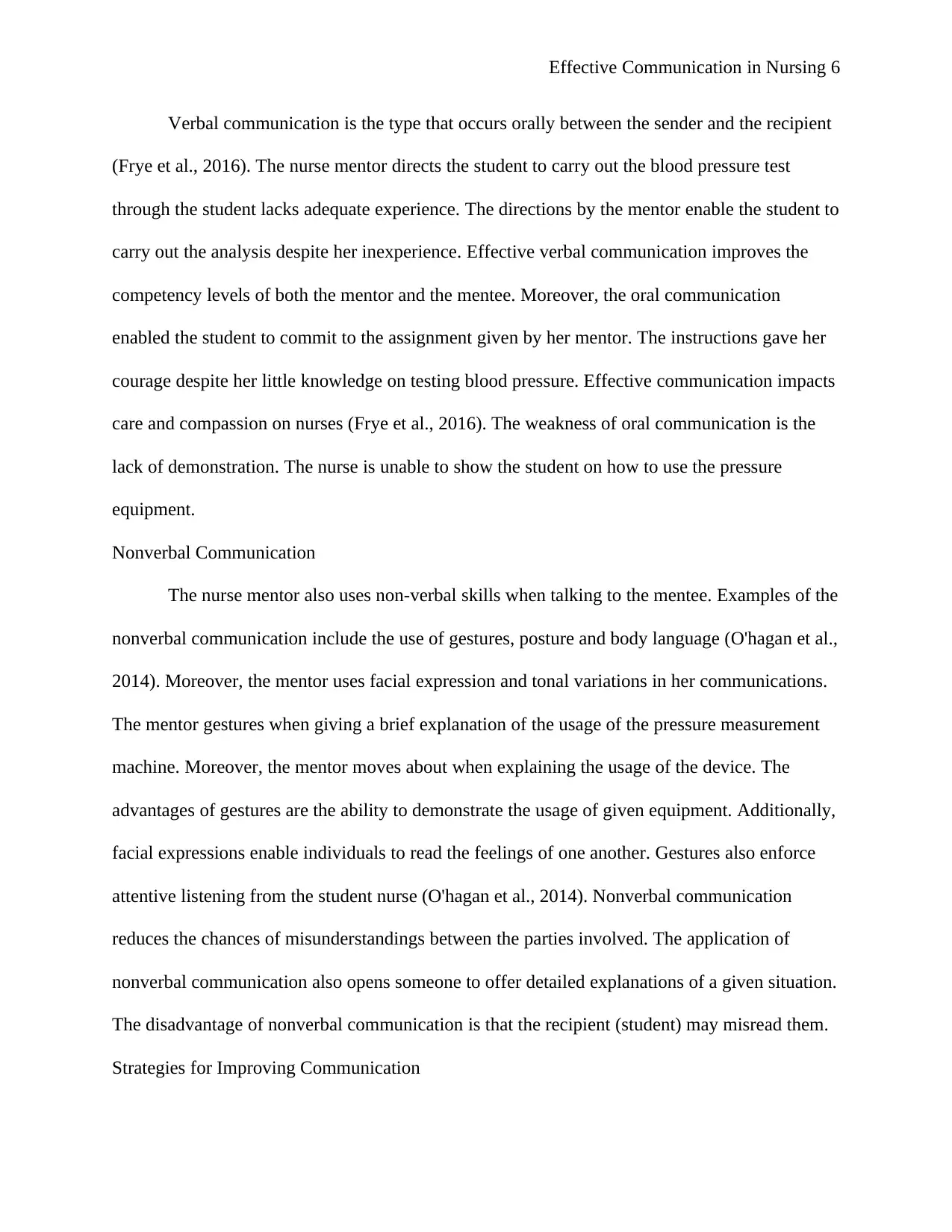
Effective Communication in Nursing 6
Verbal communication is the type that occurs orally between the sender and the recipient
(Frye et al., 2016). The nurse mentor directs the student to carry out the blood pressure test
through the student lacks adequate experience. The directions by the mentor enable the student to
carry out the analysis despite her inexperience. Effective verbal communication improves the
competency levels of both the mentor and the mentee. Moreover, the oral communication
enabled the student to commit to the assignment given by her mentor. The instructions gave her
courage despite her little knowledge on testing blood pressure. Effective communication impacts
care and compassion on nurses (Frye et al., 2016). The weakness of oral communication is the
lack of demonstration. The nurse is unable to show the student on how to use the pressure
equipment.
Nonverbal Communication
The nurse mentor also uses non-verbal skills when talking to the mentee. Examples of the
nonverbal communication include the use of gestures, posture and body language (O'hagan et al.,
2014). Moreover, the mentor uses facial expression and tonal variations in her communications.
The mentor gestures when giving a brief explanation of the usage of the pressure measurement
machine. Moreover, the mentor moves about when explaining the usage of the device. The
advantages of gestures are the ability to demonstrate the usage of given equipment. Additionally,
facial expressions enable individuals to read the feelings of one another. Gestures also enforce
attentive listening from the student nurse (O'hagan et al., 2014). Nonverbal communication
reduces the chances of misunderstandings between the parties involved. The application of
nonverbal communication also opens someone to offer detailed explanations of a given situation.
The disadvantage of nonverbal communication is that the recipient (student) may misread them.
Strategies for Improving Communication
Verbal communication is the type that occurs orally between the sender and the recipient
(Frye et al., 2016). The nurse mentor directs the student to carry out the blood pressure test
through the student lacks adequate experience. The directions by the mentor enable the student to
carry out the analysis despite her inexperience. Effective verbal communication improves the
competency levels of both the mentor and the mentee. Moreover, the oral communication
enabled the student to commit to the assignment given by her mentor. The instructions gave her
courage despite her little knowledge on testing blood pressure. Effective communication impacts
care and compassion on nurses (Frye et al., 2016). The weakness of oral communication is the
lack of demonstration. The nurse is unable to show the student on how to use the pressure
equipment.
Nonverbal Communication
The nurse mentor also uses non-verbal skills when talking to the mentee. Examples of the
nonverbal communication include the use of gestures, posture and body language (O'hagan et al.,
2014). Moreover, the mentor uses facial expression and tonal variations in her communications.
The mentor gestures when giving a brief explanation of the usage of the pressure measurement
machine. Moreover, the mentor moves about when explaining the usage of the device. The
advantages of gestures are the ability to demonstrate the usage of given equipment. Additionally,
facial expressions enable individuals to read the feelings of one another. Gestures also enforce
attentive listening from the student nurse (O'hagan et al., 2014). Nonverbal communication
reduces the chances of misunderstandings between the parties involved. The application of
nonverbal communication also opens someone to offer detailed explanations of a given situation.
The disadvantage of nonverbal communication is that the recipient (student) may misread them.
Strategies for Improving Communication
⊘ This is a preview!⊘
Do you want full access?
Subscribe today to unlock all pages.

Trusted by 1+ million students worldwide
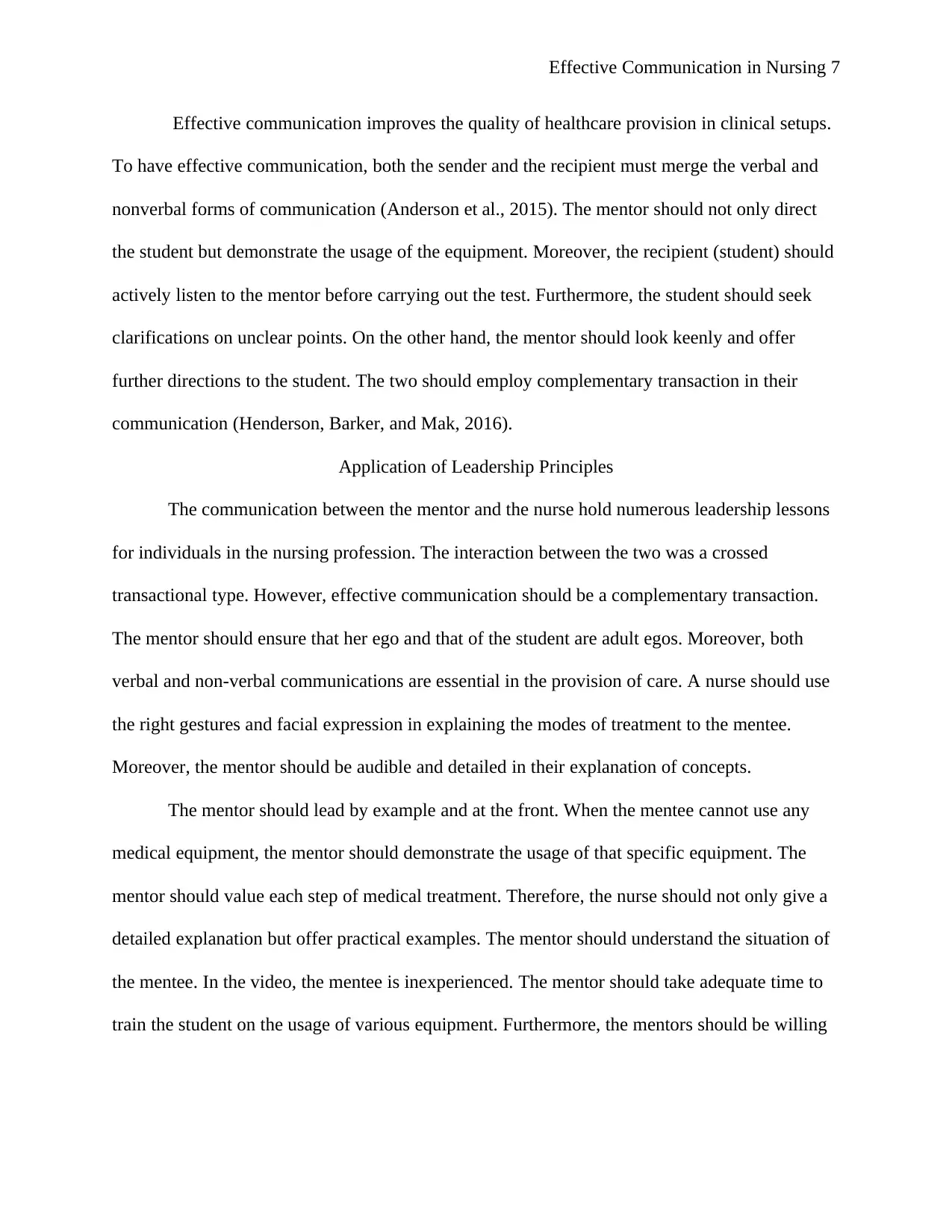
Effective Communication in Nursing 7
Effective communication improves the quality of healthcare provision in clinical setups.
To have effective communication, both the sender and the recipient must merge the verbal and
nonverbal forms of communication (Anderson et al., 2015). The mentor should not only direct
the student but demonstrate the usage of the equipment. Moreover, the recipient (student) should
actively listen to the mentor before carrying out the test. Furthermore, the student should seek
clarifications on unclear points. On the other hand, the mentor should look keenly and offer
further directions to the student. The two should employ complementary transaction in their
communication (Henderson, Barker, and Mak, 2016).
Application of Leadership Principles
The communication between the mentor and the nurse hold numerous leadership lessons
for individuals in the nursing profession. The interaction between the two was a crossed
transactional type. However, effective communication should be a complementary transaction.
The mentor should ensure that her ego and that of the student are adult egos. Moreover, both
verbal and non-verbal communications are essential in the provision of care. A nurse should use
the right gestures and facial expression in explaining the modes of treatment to the mentee.
Moreover, the mentor should be audible and detailed in their explanation of concepts.
The mentor should lead by example and at the front. When the mentee cannot use any
medical equipment, the mentor should demonstrate the usage of that specific equipment. The
mentor should value each step of medical treatment. Therefore, the nurse should not only give a
detailed explanation but offer practical examples. The mentor should understand the situation of
the mentee. In the video, the mentee is inexperienced. The mentor should take adequate time to
train the student on the usage of various equipment. Furthermore, the mentors should be willing
Effective communication improves the quality of healthcare provision in clinical setups.
To have effective communication, both the sender and the recipient must merge the verbal and
nonverbal forms of communication (Anderson et al., 2015). The mentor should not only direct
the student but demonstrate the usage of the equipment. Moreover, the recipient (student) should
actively listen to the mentor before carrying out the test. Furthermore, the student should seek
clarifications on unclear points. On the other hand, the mentor should look keenly and offer
further directions to the student. The two should employ complementary transaction in their
communication (Henderson, Barker, and Mak, 2016).
Application of Leadership Principles
The communication between the mentor and the nurse hold numerous leadership lessons
for individuals in the nursing profession. The interaction between the two was a crossed
transactional type. However, effective communication should be a complementary transaction.
The mentor should ensure that her ego and that of the student are adult egos. Moreover, both
verbal and non-verbal communications are essential in the provision of care. A nurse should use
the right gestures and facial expression in explaining the modes of treatment to the mentee.
Moreover, the mentor should be audible and detailed in their explanation of concepts.
The mentor should lead by example and at the front. When the mentee cannot use any
medical equipment, the mentor should demonstrate the usage of that specific equipment. The
mentor should value each step of medical treatment. Therefore, the nurse should not only give a
detailed explanation but offer practical examples. The mentor should understand the situation of
the mentee. In the video, the mentee is inexperienced. The mentor should take adequate time to
train the student on the usage of various equipment. Furthermore, the mentors should be willing
Paraphrase This Document
Need a fresh take? Get an instant paraphrase of this document with our AI Paraphraser
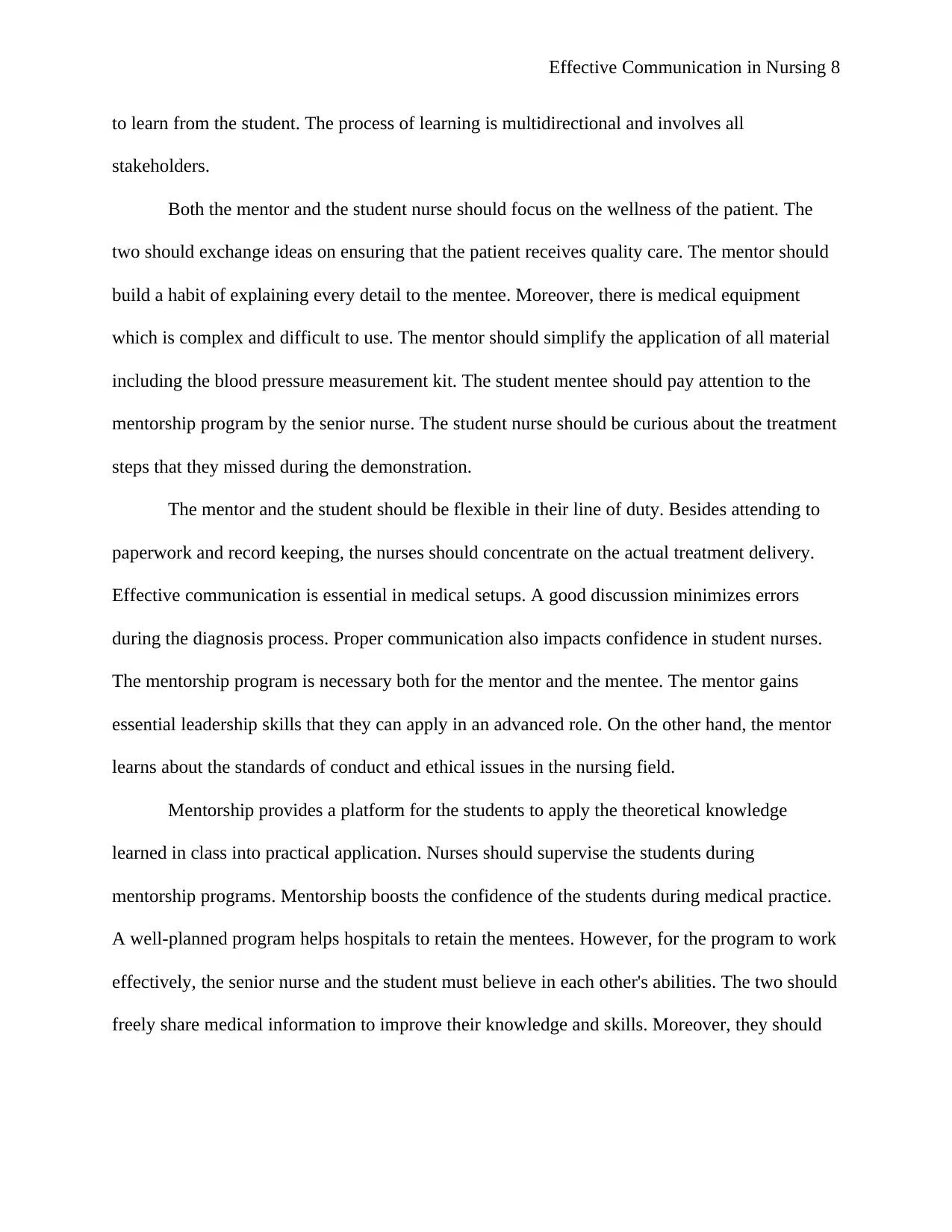
Effective Communication in Nursing 8
to learn from the student. The process of learning is multidirectional and involves all
stakeholders.
Both the mentor and the student nurse should focus on the wellness of the patient. The
two should exchange ideas on ensuring that the patient receives quality care. The mentor should
build a habit of explaining every detail to the mentee. Moreover, there is medical equipment
which is complex and difficult to use. The mentor should simplify the application of all material
including the blood pressure measurement kit. The student mentee should pay attention to the
mentorship program by the senior nurse. The student nurse should be curious about the treatment
steps that they missed during the demonstration.
The mentor and the student should be flexible in their line of duty. Besides attending to
paperwork and record keeping, the nurses should concentrate on the actual treatment delivery.
Effective communication is essential in medical setups. A good discussion minimizes errors
during the diagnosis process. Proper communication also impacts confidence in student nurses.
The mentorship program is necessary both for the mentor and the mentee. The mentor gains
essential leadership skills that they can apply in an advanced role. On the other hand, the mentor
learns about the standards of conduct and ethical issues in the nursing field.
Mentorship provides a platform for the students to apply the theoretical knowledge
learned in class into practical application. Nurses should supervise the students during
mentorship programs. Mentorship boosts the confidence of the students during medical practice.
A well-planned program helps hospitals to retain the mentees. However, for the program to work
effectively, the senior nurse and the student must believe in each other's abilities. The two should
freely share medical information to improve their knowledge and skills. Moreover, they should
to learn from the student. The process of learning is multidirectional and involves all
stakeholders.
Both the mentor and the student nurse should focus on the wellness of the patient. The
two should exchange ideas on ensuring that the patient receives quality care. The mentor should
build a habit of explaining every detail to the mentee. Moreover, there is medical equipment
which is complex and difficult to use. The mentor should simplify the application of all material
including the blood pressure measurement kit. The student mentee should pay attention to the
mentorship program by the senior nurse. The student nurse should be curious about the treatment
steps that they missed during the demonstration.
The mentor and the student should be flexible in their line of duty. Besides attending to
paperwork and record keeping, the nurses should concentrate on the actual treatment delivery.
Effective communication is essential in medical setups. A good discussion minimizes errors
during the diagnosis process. Proper communication also impacts confidence in student nurses.
The mentorship program is necessary both for the mentor and the mentee. The mentor gains
essential leadership skills that they can apply in an advanced role. On the other hand, the mentor
learns about the standards of conduct and ethical issues in the nursing field.
Mentorship provides a platform for the students to apply the theoretical knowledge
learned in class into practical application. Nurses should supervise the students during
mentorship programs. Mentorship boosts the confidence of the students during medical practice.
A well-planned program helps hospitals to retain the mentees. However, for the program to work
effectively, the senior nurse and the student must believe in each other's abilities. The two should
freely share medical information to improve their knowledge and skills. Moreover, they should
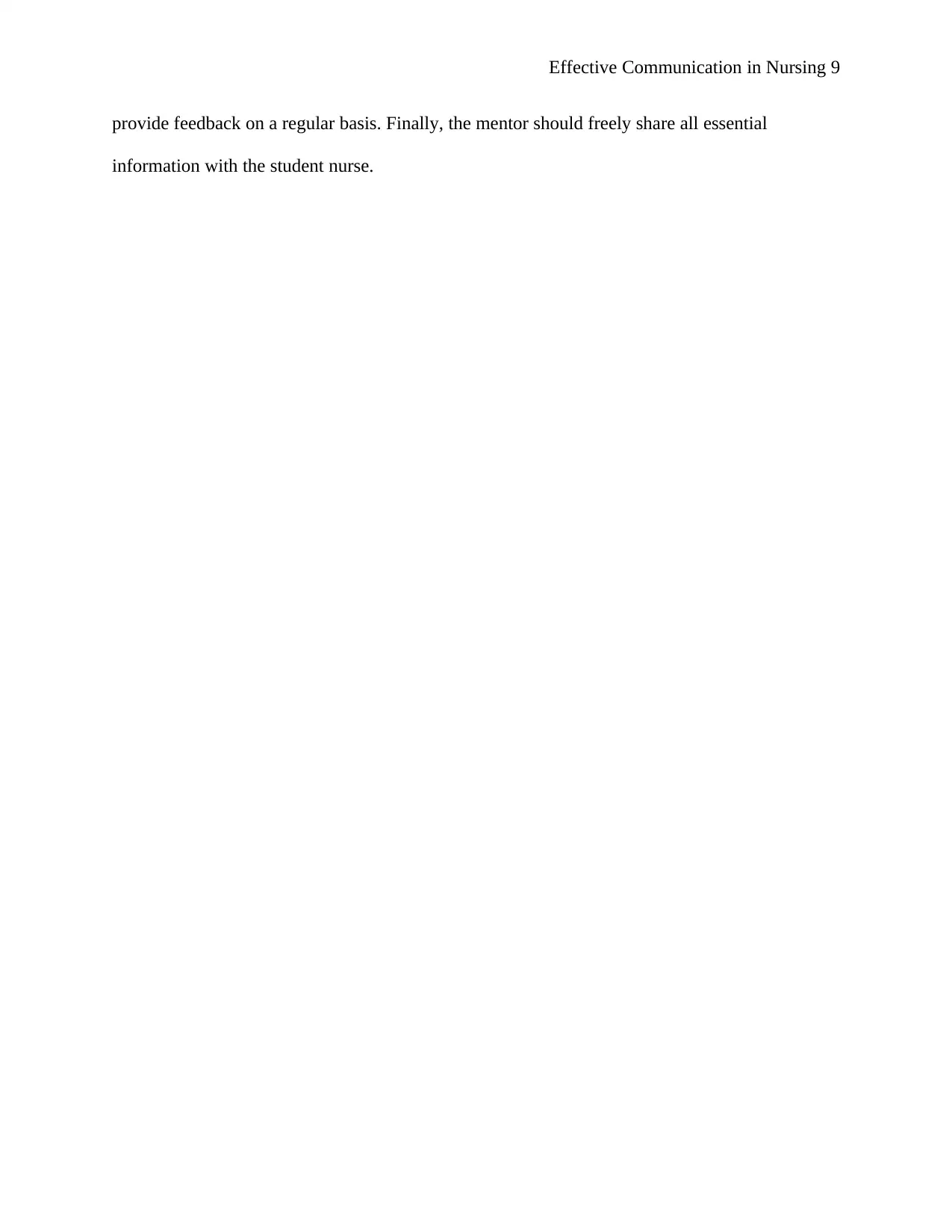
Effective Communication in Nursing 9
provide feedback on a regular basis. Finally, the mentor should freely share all essential
information with the student nurse.
provide feedback on a regular basis. Finally, the mentor should freely share all essential
information with the student nurse.
⊘ This is a preview!⊘
Do you want full access?
Subscribe today to unlock all pages.

Trusted by 1+ million students worldwide
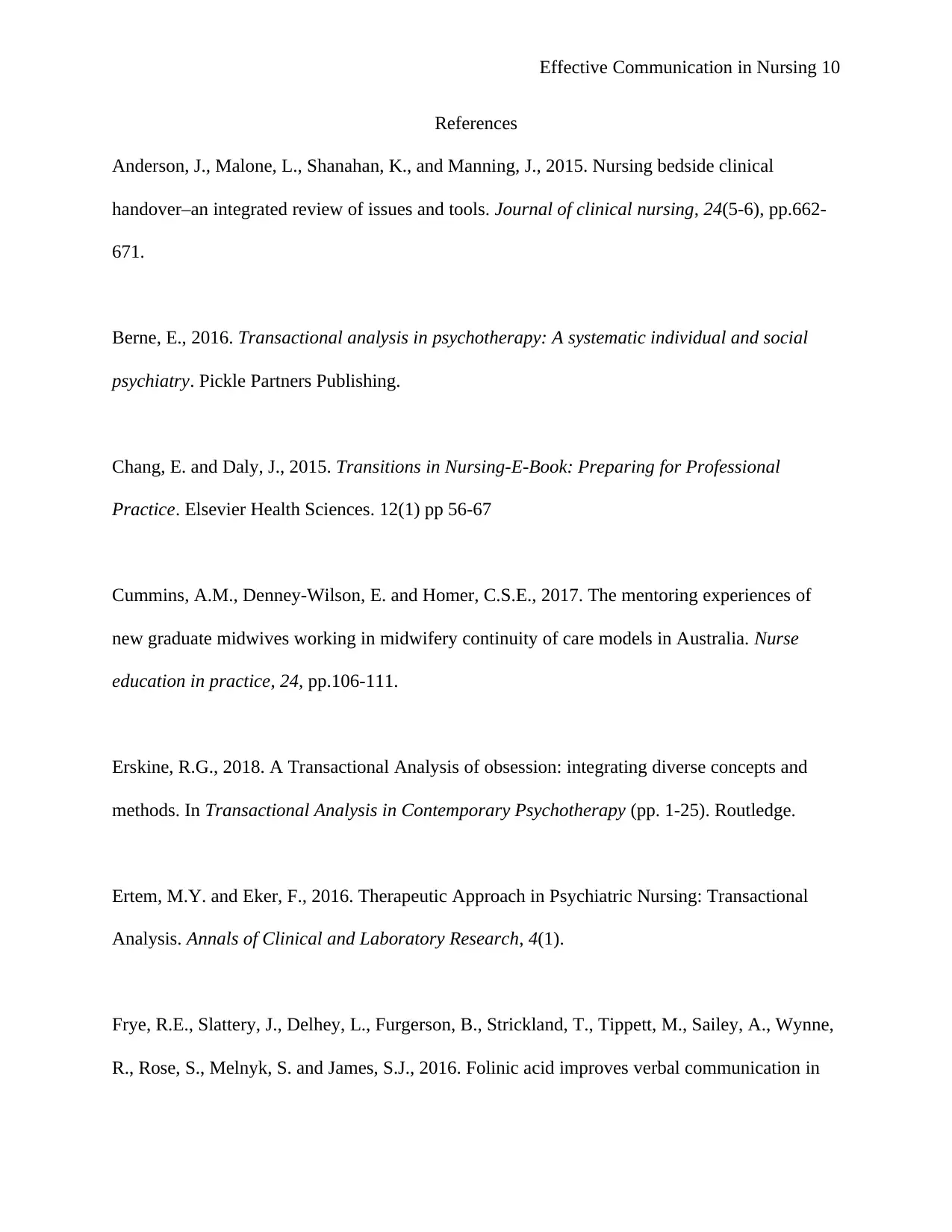
Effective Communication in Nursing 10
References
Anderson, J., Malone, L., Shanahan, K., and Manning, J., 2015. Nursing bedside clinical
handover–an integrated review of issues and tools. Journal of clinical nursing, 24(5-6), pp.662-
671.
Berne, E., 2016. Transactional analysis in psychotherapy: A systematic individual and social
psychiatry. Pickle Partners Publishing.
Chang, E. and Daly, J., 2015. Transitions in Nursing-E-Book: Preparing for Professional
Practice. Elsevier Health Sciences. 12(1) pp 56-67
Cummins, A.M., Denney-Wilson, E. and Homer, C.S.E., 2017. The mentoring experiences of
new graduate midwives working in midwifery continuity of care models in Australia. Nurse
education in practice, 24, pp.106-111.
Erskine, R.G., 2018. A Transactional Analysis of obsession: integrating diverse concepts and
methods. In Transactional Analysis in Contemporary Psychotherapy (pp. 1-25). Routledge.
Ertem, M.Y. and Eker, F., 2016. Therapeutic Approach in Psychiatric Nursing: Transactional
Analysis. Annals of Clinical and Laboratory Research, 4(1).
Frye, R.E., Slattery, J., Delhey, L., Furgerson, B., Strickland, T., Tippett, M., Sailey, A., Wynne,
R., Rose, S., Melnyk, S. and James, S.J., 2016. Folinic acid improves verbal communication in
References
Anderson, J., Malone, L., Shanahan, K., and Manning, J., 2015. Nursing bedside clinical
handover–an integrated review of issues and tools. Journal of clinical nursing, 24(5-6), pp.662-
671.
Berne, E., 2016. Transactional analysis in psychotherapy: A systematic individual and social
psychiatry. Pickle Partners Publishing.
Chang, E. and Daly, J., 2015. Transitions in Nursing-E-Book: Preparing for Professional
Practice. Elsevier Health Sciences. 12(1) pp 56-67
Cummins, A.M., Denney-Wilson, E. and Homer, C.S.E., 2017. The mentoring experiences of
new graduate midwives working in midwifery continuity of care models in Australia. Nurse
education in practice, 24, pp.106-111.
Erskine, R.G., 2018. A Transactional Analysis of obsession: integrating diverse concepts and
methods. In Transactional Analysis in Contemporary Psychotherapy (pp. 1-25). Routledge.
Ertem, M.Y. and Eker, F., 2016. Therapeutic Approach in Psychiatric Nursing: Transactional
Analysis. Annals of Clinical and Laboratory Research, 4(1).
Frye, R.E., Slattery, J., Delhey, L., Furgerson, B., Strickland, T., Tippett, M., Sailey, A., Wynne,
R., Rose, S., Melnyk, S. and James, S.J., 2016. Folinic acid improves verbal communication in
Paraphrase This Document
Need a fresh take? Get an instant paraphrase of this document with our AI Paraphraser
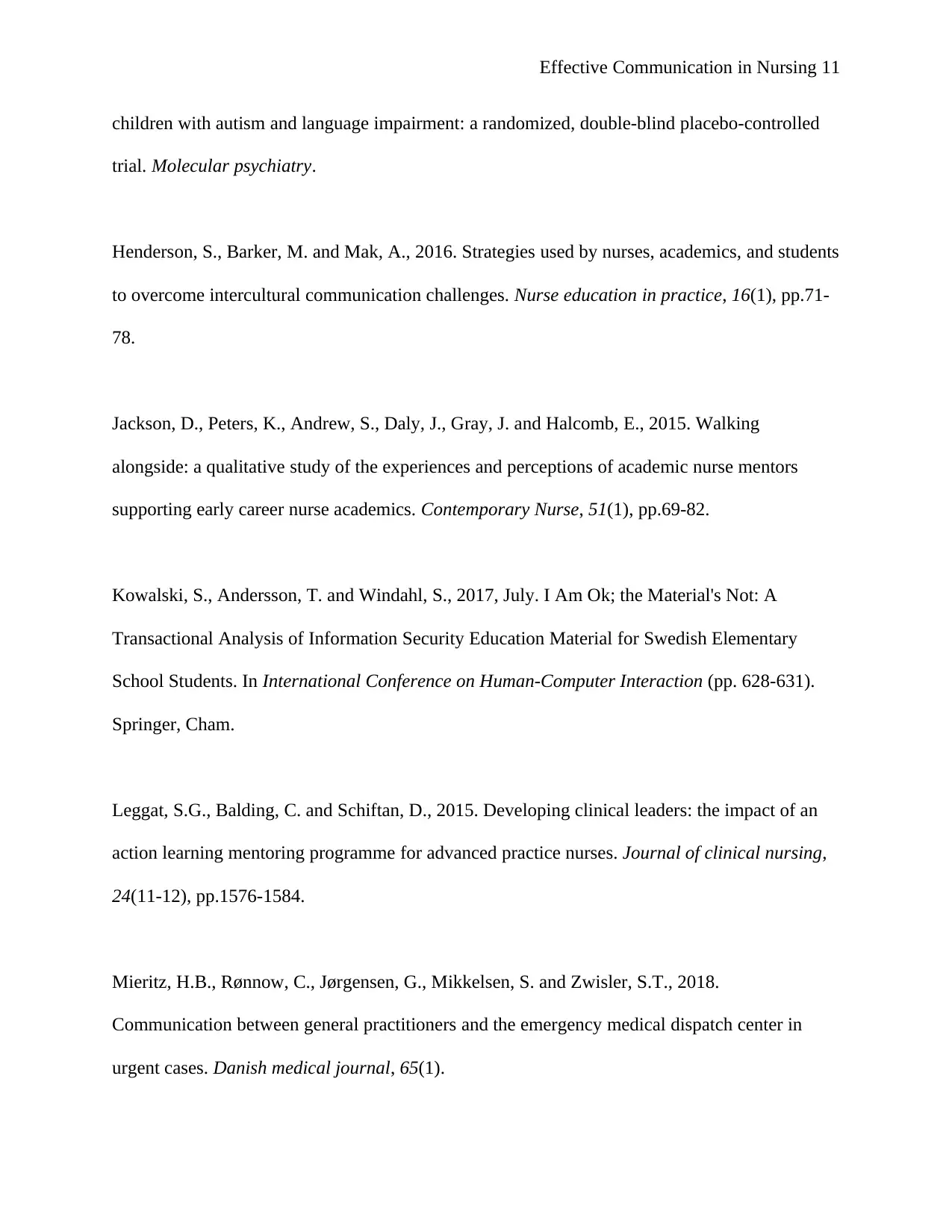
Effective Communication in Nursing 11
children with autism and language impairment: a randomized, double-blind placebo-controlled
trial. Molecular psychiatry.
Henderson, S., Barker, M. and Mak, A., 2016. Strategies used by nurses, academics, and students
to overcome intercultural communication challenges. Nurse education in practice, 16(1), pp.71-
78.
Jackson, D., Peters, K., Andrew, S., Daly, J., Gray, J. and Halcomb, E., 2015. Walking
alongside: a qualitative study of the experiences and perceptions of academic nurse mentors
supporting early career nurse academics. Contemporary Nurse, 51(1), pp.69-82.
Kowalski, S., Andersson, T. and Windahl, S., 2017, July. I Am Ok; the Material's Not: A
Transactional Analysis of Information Security Education Material for Swedish Elementary
School Students. In International Conference on Human-Computer Interaction (pp. 628-631).
Springer, Cham.
Leggat, S.G., Balding, C. and Schiftan, D., 2015. Developing clinical leaders: the impact of an
action learning mentoring programme for advanced practice nurses. Journal of clinical nursing,
24(11-12), pp.1576-1584.
Mieritz, H.B., Rønnow, C., Jørgensen, G., Mikkelsen, S. and Zwisler, S.T., 2018.
Communication between general practitioners and the emergency medical dispatch center in
urgent cases. Danish medical journal, 65(1).
children with autism and language impairment: a randomized, double-blind placebo-controlled
trial. Molecular psychiatry.
Henderson, S., Barker, M. and Mak, A., 2016. Strategies used by nurses, academics, and students
to overcome intercultural communication challenges. Nurse education in practice, 16(1), pp.71-
78.
Jackson, D., Peters, K., Andrew, S., Daly, J., Gray, J. and Halcomb, E., 2015. Walking
alongside: a qualitative study of the experiences and perceptions of academic nurse mentors
supporting early career nurse academics. Contemporary Nurse, 51(1), pp.69-82.
Kowalski, S., Andersson, T. and Windahl, S., 2017, July. I Am Ok; the Material's Not: A
Transactional Analysis of Information Security Education Material for Swedish Elementary
School Students. In International Conference on Human-Computer Interaction (pp. 628-631).
Springer, Cham.
Leggat, S.G., Balding, C. and Schiftan, D., 2015. Developing clinical leaders: the impact of an
action learning mentoring programme for advanced practice nurses. Journal of clinical nursing,
24(11-12), pp.1576-1584.
Mieritz, H.B., Rønnow, C., Jørgensen, G., Mikkelsen, S. and Zwisler, S.T., 2018.
Communication between general practitioners and the emergency medical dispatch center in
urgent cases. Danish medical journal, 65(1).
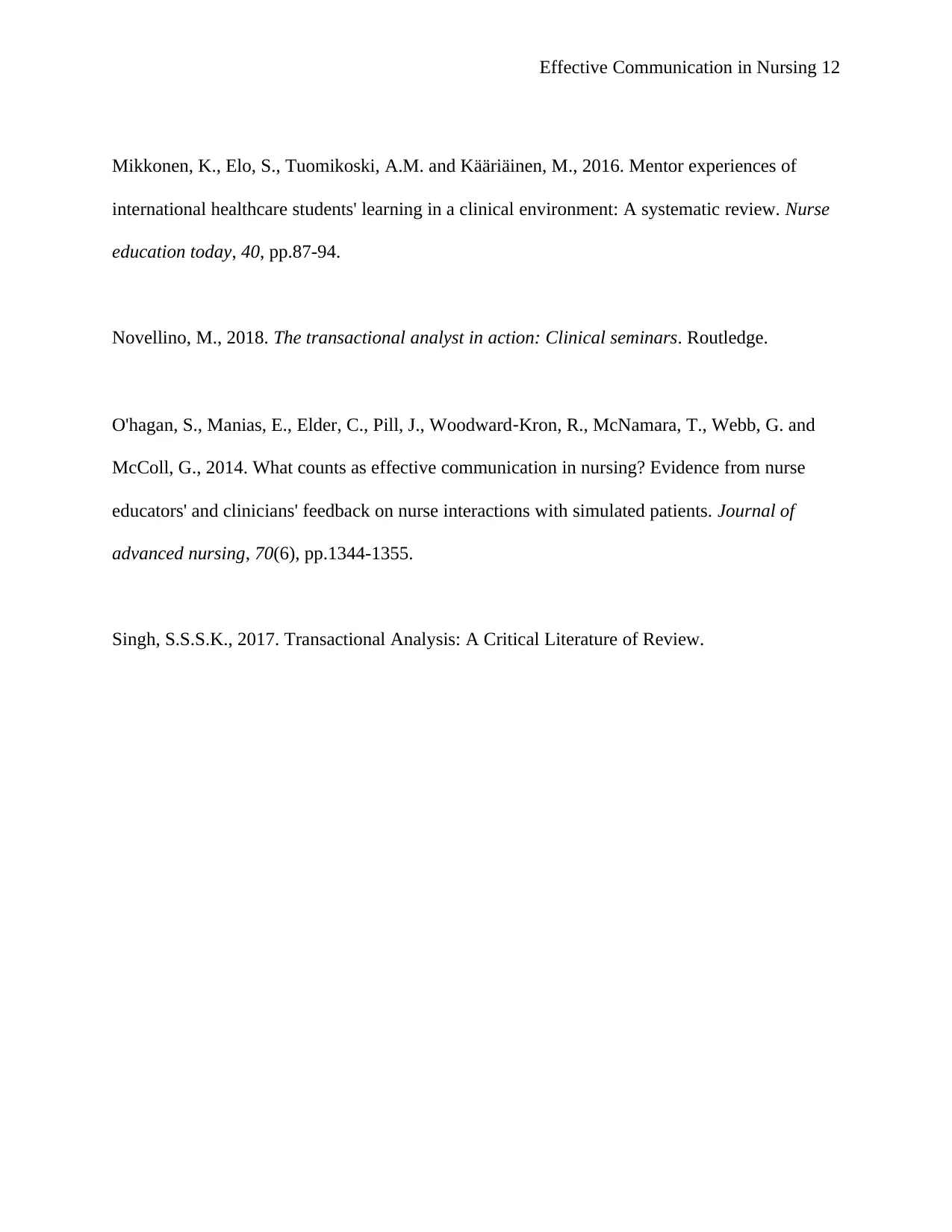
Effective Communication in Nursing 12
Mikkonen, K., Elo, S., Tuomikoski, A.M. and Kääriäinen, M., 2016. Mentor experiences of
international healthcare students' learning in a clinical environment: A systematic review. Nurse
education today, 40, pp.87-94.
Novellino, M., 2018. The transactional analyst in action: Clinical seminars. Routledge.
O'hagan, S., Manias, E., Elder, C., Pill, J., Woodward‐Kron, R., McNamara, T., Webb, G. and
McColl, G., 2014. What counts as effective communication in nursing? Evidence from nurse
educators' and clinicians' feedback on nurse interactions with simulated patients. Journal of
advanced nursing, 70(6), pp.1344-1355.
Singh, S.S.S.K., 2017. Transactional Analysis: A Critical Literature of Review.
Mikkonen, K., Elo, S., Tuomikoski, A.M. and Kääriäinen, M., 2016. Mentor experiences of
international healthcare students' learning in a clinical environment: A systematic review. Nurse
education today, 40, pp.87-94.
Novellino, M., 2018. The transactional analyst in action: Clinical seminars. Routledge.
O'hagan, S., Manias, E., Elder, C., Pill, J., Woodward‐Kron, R., McNamara, T., Webb, G. and
McColl, G., 2014. What counts as effective communication in nursing? Evidence from nurse
educators' and clinicians' feedback on nurse interactions with simulated patients. Journal of
advanced nursing, 70(6), pp.1344-1355.
Singh, S.S.S.K., 2017. Transactional Analysis: A Critical Literature of Review.
⊘ This is a preview!⊘
Do you want full access?
Subscribe today to unlock all pages.

Trusted by 1+ million students worldwide
1 out of 12
Related Documents
Your All-in-One AI-Powered Toolkit for Academic Success.
+13062052269
info@desklib.com
Available 24*7 on WhatsApp / Email
![[object Object]](/_next/static/media/star-bottom.7253800d.svg)
Unlock your academic potential
Copyright © 2020–2025 A2Z Services. All Rights Reserved. Developed and managed by ZUCOL.




